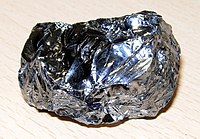
Photo from wikipedia
Portland cement emits bright near-infrared photoluminescence that can be excited by light wavelengths ranging from at least 500–1000 nm. The emission has a peak wavelength near 1140 nm and a… Click to show full abstract
Portland cement emits bright near-infrared photoluminescence that can be excited by light wavelengths ranging from at least 500–1000 nm. The emission has a peak wavelength near 1140 nm and a width of approximately 30 nm. Its source is suggested to be small particles of silicon associated with calcium silicate phases. The luminescence peak wavelength appears independent of the cement hydration state, aggregates, and mechanical strain but increases weakly with increasing temperature. It varies slightly with the type of cement, suggesting a new non-contact method for identifying cement formulations. After a thin opaque coating is applied to a cement or concrete surface, subsequent formation of microcracks exposes the substrate’s near-infrared emission, revealing the fracture locations, pattern, and progression. This damage would escape detection in normal imaging inspections. Near-infrared luminescence imaging may therefore provide a new tool for non-destructive testing of cement-based structures.
Journal Title: Scientific Reports
Year Published: 2022
Link to full text (if available)
Share on Social Media: Sign Up to like & get
recommendations!